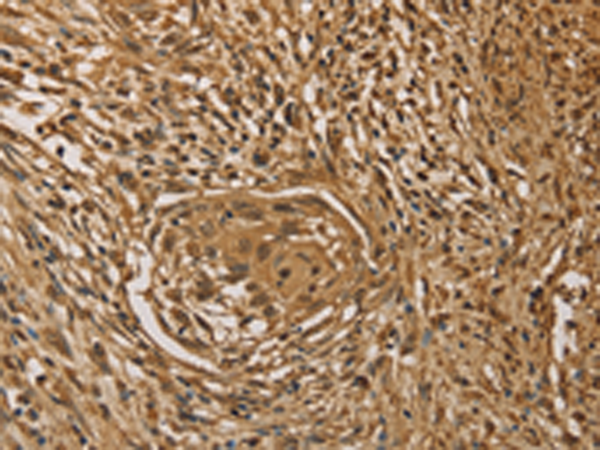

| WB | 咨询技术 | Human,Mouse,Rat |
| IF | 咨询技术 | Human,Mouse,Rat |
| IHC | 1/100-1/300 | Human,Mouse,Rat |
| ICC | 技术咨询 | Human,Mouse,Rat |
| FCM | 咨询技术 | Human,Mouse,Rat |
| Elisa | 1/2000-1/10000 | Human,Mouse,Rat |
| Aliases | PFM11 |
| Host/Isotype | Rabbit IgG |
| Antibody Type | Primary antibody |
| Storage | Store at 4°C short term. Aliquot and store at -20°C long term. Avoid freeze/thaw cycles. |
| Species Reactivity | Human, Mouse |
| Immunogen | Fusion protein of human PRDM14 |
| Formulation | Purified antibody in PBS with 0.05% sodium azide and 50% glycerol. |
+ +
以下是关于PRDM14抗体的3篇参考文献,按文献名称、作者和摘要内容简要概括:
1. **《PRDM14 ensures naive pluripotency through dual regulation of signaling and epigenetic pathways in mouse embryonic stem cells》**
- **作者**:Yamaji, M., et al.
- **摘要**:研究利用PRDM14特异性抗体,通过ChIP-seq和免疫沉淀技术,揭示PRDM14在小鼠胚胎干细胞中通过调控信号通路(如FGF/ERK)和表观遗传修饰(如H3K9me3)维持初始多能性的机制。
2. **《PRDM14 promotes active DNA demethylation through the regulation of TET and TDG in mouse primordial germ cells》**
- **作者**:Okashita, N., et al.
- **摘要**:通过PRDM14抗体的免疫荧光和Western blot分析,发现PRDM14在原始生殖细胞(PGCs)中通过激活TET酶和胸腺嘧啶DNA糖基化酶(TDG),促进DNA主动去甲基化,影响生殖细胞重编程。
3. **《PRDM14 is a novel therapeutic target for tyrosine kinase inhibitor-resistant leukemia stem cells》**
- **作者**:Nishikawa, S., et al.
- **摘要**:研究使用PRDM14抗体进行流式细胞术和免疫组化,发现PRDM14在酪氨酸激酶抑制剂耐药的白血病干细胞中高表达,靶向抑制PRDM14可恢复药物敏感性并抑制肿瘤生长。
以上研究均涉及PRDM14抗体的实验应用(如蛋白检测、定位分析),涵盖干细胞多能性、生殖细胞发育及癌症治疗机制等领域。
PRDM14 is a transcription factor belonging to the PRDI-BF1 and RIZ homology (PRDM) protein family, characterized by a PR (PRDI-BF1-RIZ1 homologous) domain and zinc finger motifs. It plays critical roles in epigenetic regulation, pluripotency maintenance in embryonic stem cells, and germline development. PRDM14 modulates gene expression by recruiting histone-modifying enzymes, influencing chromatin states at target loci. Its expression is tightly regulated, with high activity in early embryogenesis and primordial germ cells but limited in somatic tissues. Dysregulation of PRDM14 is implicated in cancer, particularly in aggressive malignancies like breast cancer and germ cell tumors, where it may act as an oncogene by promoting stem-like properties and chemoresistance.
PRDM14 antibodies are essential tools for studying its expression, localization, and function. These antibodies enable detection via techniques such as Western blotting, immunohistochemistry, and immunofluorescence, aiding research into PRDM14’s role in development and disease. Specificity and validation are crucial, as cross-reactivity with other PRDM family members (e.g., PRDM1 or PRDM5) can occur. Researchers often verify antibody performance using knockout cell lines or siRNA-mediated knockdown. Commercial PRDM14 antibodies are typically raised against epitopes within its N-terminal region or zinc finger domains. Understanding PRDM14’s context-dependent roles—acting as both a pluripotency factor and potential oncoprotein—underscores the importance of reliable antibodies in dissecting its dualistic contributions to normal biology and pathology.
×